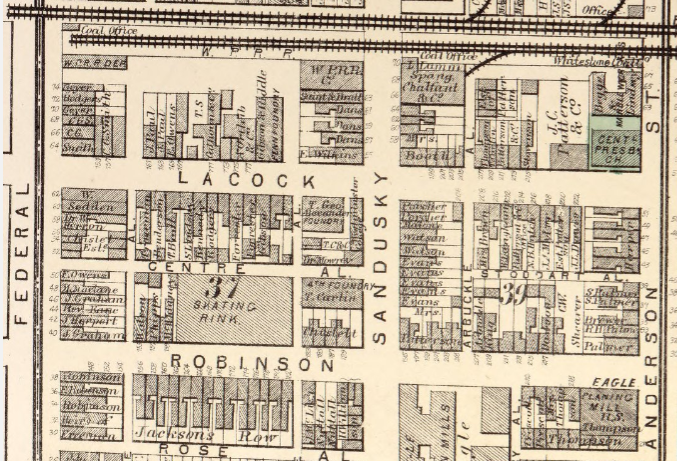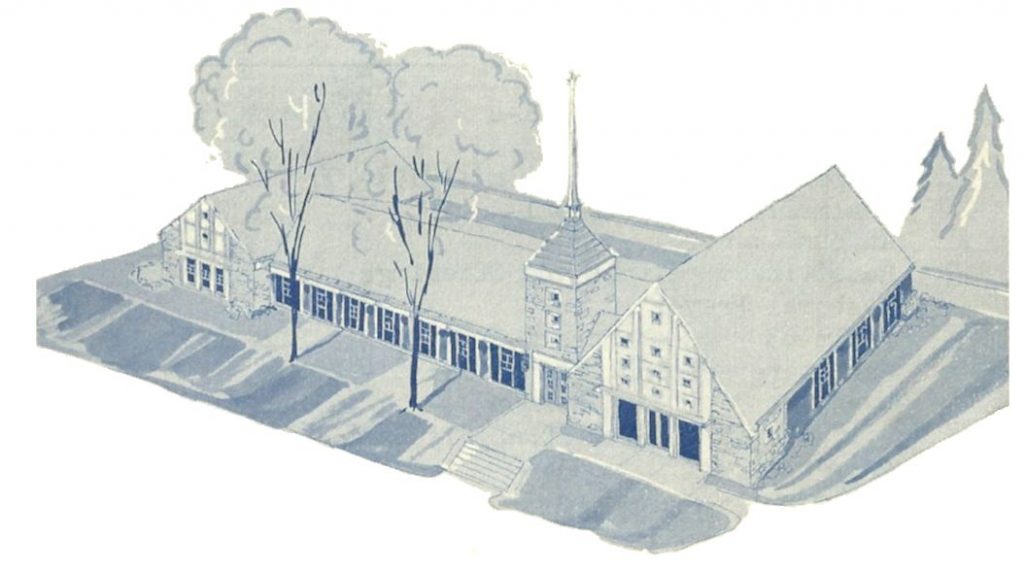History of the Reformed Presbyterian Church of the North Hills
In 1800, soon after the birth of our nation, the area we call North Hills of Pittsburgh was rolling hills, farmland, and country roads. The North Hills congregation emerged from the work of Christ’s church in the Pittsburgh area during this early period in our country’s history. This brief history follows the church through many changes, including its move from the city of Pittsburgh to suburban North Hills, and to her present situation. Here, the reader will receive but a glimpse of a congregation striving to be a light in this world.
In the Beginning, 1780-1833
At this point in our Nation’s history, any area past the Appalachian Mountains was considered West. The first Covenanter church in the Pittsburgh area was referenced as the Monongahela congregation, organized in 1779. The origin of the North Hills congregation starts with a congregation referenced as “Ohio”, which was organized on December 18, 1800 under the leadership of John Black.
Dr. Black served as pastor of this church until 1833 when the first split occurred and he and other members left the Reformed Presbyterian denomination. The cause of this division may serve as a framework in which to view the life of this church. Only 45 years earlier, the Constitution of the United States was formally ratified, and it was the Covenanter church that stood against it because it both failed to recognize Christ as King and Lord and did nothing to condemn and abolish the enslavement of human beings in America. The denomination held that its members should not participate in the election of persons who must take an oath to defend this godless document. Neither were members to join in worship or communion with those that owned slaves. It was his recently found conflict with the position of political dissent that motivated Dr. Black and many others from the Pittsburgh church to abandon it to form what was known as the “New Light” or “General Synod” RP Church. Those who remained, about 13 members, were reorganized into what was thereafter referenced as the Pittsburgh and Allegheny Congregation.
1833-1865
These thirteen people who remained loyal to the Covenanter church now needed to find a place of worship. With Rev. Thomas Sproul as pastor, they met in the City Courthouse for several years until they built a church on the corner of Lacock and Anderson Street, which was in the Fourth Ward of the town of Allegheny.

Allegheny City 4th Ward map, 1872
Not actually being located in the city was a source of conflict over the next thirty years, but the church grew. It appears that much of the early preaching and character of the early pastors centered on the distinctives of the church’s position regarding slavery, voting, and the kingship of Christ. In 1865, Rev. Sproul, feeling overwhelmed by the challenges of a large church, asked either for an assistant or for members living in Pittsburgh to form their own congregation. The members living in Pittsburgh chose to form their own congregation, and in early 1866, A.M. Milligan was installed as the Pittsburgh church’s first pastor.
1866-1928
More growth and transition followed over the next 60 years in the life of the congregation. In 1870, the Pittsburgh church moved from meeting in City Hall to its own building on Eighth Street and called itself the Eighth Street R.P. Church. At the same time a split occurred in the Allegheny Church and a new church, the Central Allegheny R.P. Church was formed. Thus, three Reformed Presbyterian congregations coexisted in the Pittsburgh area starting in 1870. Reverend Thomas Sproul was installed in 1870 in the Central Allegheny R.P. Church and continued as pastor until his death in 1910.
These realignments occurred during another crucial period in the life of our Nation. The waning years of the American Civil War served as the setting through which this denomination and the Pittsburgh church served as a witness to the truth of the Gospel. Histories written about the Pittsburgh church in the late 1860’s report that the Secretary of War at the time, a native Pittsburgher, counted on the loyalty and trustworthiness of the Covenanters in fighting for the Union on the battlefields and in prayer. The church faithfully served the black community and other minorities in Pittsburgh during this era.
The Eighth Street congregation continued to prosper, and at one point at the close of the 1800’s had nearly 450 children in its Sabbath School program. At the climax of this growth, the Central Allegheny R.P. Church and the Eighth Street R.P. Church began discussing the possibility of a merger in 1927.
Meanwhile, Reverend John Yates pastored the Central Allegheny R.P. Church after the passing of Reverend Sproul, and continued until 1916. At that time, Dr. Robert Cameron Reed was installed as pastor. Then in 1927, under the leadership of Delber Elliot, pastor of the Eighth Street R.P. Church, and Robert C. Reed of the Central Allegheny R.P. Church, the congregations merged. The merger was approved by both congregations and finalized by Presbytery in February of 1928. The new congregation, the Central Pittsburgh R.P. Church, would eventually meet in a new building on the corner of Union Avenue and Park Way.
1928-1962
Little is recorded regarding this time in the life of the Central Pittsburgh Church. The arrangements between the two congregations made Dr. Reed and Dr. Elliot Associate Pastors of the church. The sessions merged and two newly elected deacons from the Central Allegheny church joined with deacons from the Eighth Street church to form the Central Pittsburgh board of deacons. When Dr. Reed died, Dr. Elliot remained as the sole pastor of Central Pittsburgh R.P.C. Four men followed in succession after Dr. Elliot – Rev. J. Renwick Patterson (1948-1951), Dr. Clark Copeland (who served as stated supply for a time during this period in the life of the Central Pittsburgh R.P.C.), Dr. Kenneth Smith (1952-1957), and Dr. James Carson (1958-1973).
From 1958 to 1962, under the pastorate of Jim Carson, the congregation was confronted with another move, having only been in their building 30 years. The City of Pittsburgh was planning to develop the Allegheny Center on the North Side and in 1962 it became evident that they would be required to sell the church and move. The city demanded that the congregation build a new, larger building according to the city’s specifications. The cost was prohibitive. Therefore, the present property of the North Hills Church along Thompson Run Road was purchased in late 1962. Jim Carson later documented the story from his own diaries at the time, which you can read here:
Reformed Presbyterian Church of North Hills – North Side to Ross Township
Below is a sketch of the church building from a bulletin dated soon after the church moved to the North Hills:

1963-2000
The more recent history of the congregation, since 1963, chronicles the life of the Reformed Presbyterian Church of the North Hills. On March 23, 1963, ground was broken for the foundation of the new church building. The first services were held in the new building in December of that same year. Four pastors have served the North Hills congregation. We have also owned three different parsonages during that time.
The church has seen the North Hills grow from a somewhat rural area to a busy suburb. The reports and papers that accompany this history attend to the growth, challenges, and blessings that have been experienced by this congregation. The years here have been characterized by internal encouragement, family building, and various attempts at outreach. The many activities and support groups formed during this time attest to our care for each other. The picture of the church at the end of the 20th century, however, cannot be viewed separately from its foundational years.
2000-Present
In January of 2000, Harry Metzger was installed, and remains one of the current pastors. Also in that year, after a long season of prayer and shared events, the Allegheny Reformed Presbyterian Church merged into the North Hills congregation. In 2003, Martin Blocki joined the pastoral staff.
When we started to regularly utilize overflow seating for our Sunday morning worship services, plans were put in motion to daughter a congregation. In September of 2007, RPCNH sent many of our brothers and sisters to start the work of the new Grace Reformed Presbyterian Church in Gibsonia. We are thankful to see the work and growth God has provided to both congregations.
God has also enlarged the borders of our congregation in recent years. In 2008, Natalie (Weir) Faris, having grown up in the North Hills congregation, was called with her husband Daniel to South Sudan under the RP Global Missions Cush4Christ mission team, serving until 2019. In 2015, church member and medical missionary Izzi Elliott was called to the Bongolo Hospital in Gabon, providing obstetrics care and many other logistical and medical needs, serving until 2021.
Rev. Matthew Ma was hired in 2017 to serve as Director of International Ministries, reflecting a new chapter in how God is using us to bless His people at home and abroad. We have started a multi-level ESL (English as a Second Language) program for the community during the school year. God’s Word is currently preached in both Mandarin and in English each Sabbath morning, as part of a dedicated outreach to the Chinese community in the area.
We are excited to discover what further ministry God has ordained for us within the communities where we live and work, and among the citizens of the world that the Lord brings to our doors.


